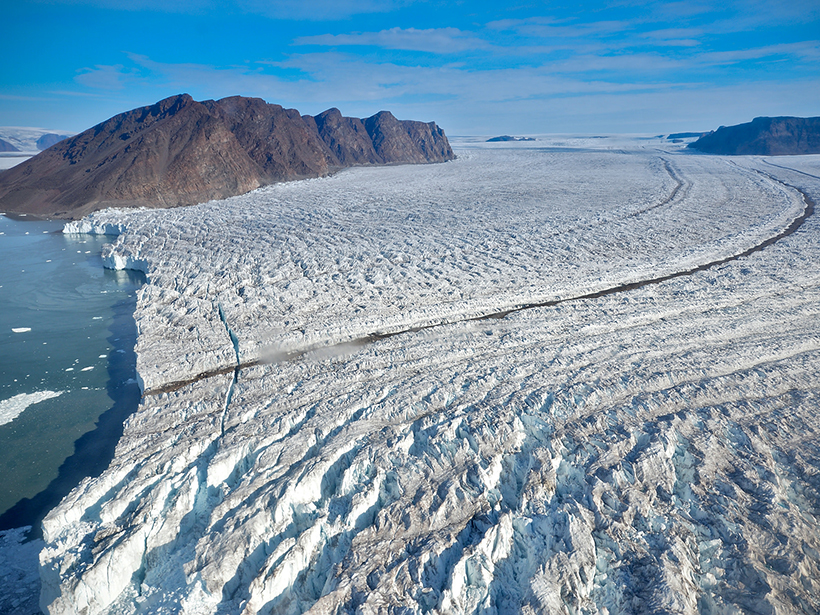The iconic image of a tidewater glacier is likely familiar, even if you’ve never seen one in person: a frozen river of icy white punctuated by blue streaks, brown-gray sediment flecks, dark, shadowy crevasses, and jagged fingerlike fronds of calving icebergs at the snout.
Glaciologist Evgeny Podolskiy thinks this perspective is lacking something important. By metaphorically closing his eyes and opening his ears, Podolskiy’s recent work has revealed that we’re missing something mysterious, dramatic, poetic, and scientifically significant: glacial sounds.
Podolskiy set out to quantify those sounds with a simple but ingenious computer: an iPhone.
Podolskiy, a scientist at the Arctic Research Center at Hokkaido University in Sapporo, Japan, has been studying glaciers in Greenland, the Himalayas, and Antarctica, collaborating with large teams using sophisticated instruments to collect data on the dynamics of our cryosphere—Earth’s icy realms. As part of Podolskiy’s and other research, arrays of different seismic waves—mostly outside of the human auditory range—are currently monitored at glaciers.
While working in July 2019 at Bowdoin Glacier in northwest Greenland, walking on ice to maintain his instruments while collecting terabytes of measurement data, Podolskiy realized that if he closed his eyes, he was in a universe of audible sounds. So he set out to quantify those sounds with a simple but ingenious computer: an iPhone. “We have it in our pockets,” marveled Podolskiy, “so instead of just Tweeting…we can actually collect information about environmental processes and study them, producing meaningful and insightful studies.”
That’s exactly what Podolskiy did, publishing the results of his iPhone-sampled tidewater glacier soundscape in Geophysical Research Letters.
Deciphering a Glacier’s Acoustic Fingerprints
Podolskiy identified three main sound sources. First, draining meltwater within a crevasse created pulsating, fluid, oscillating sounds “just like in a bathtub.” Second were bubbles bursting in a pond atop the glacier. Finally, he noted the pounding sounds inside a moulin, the often circular, well-like shafts on an ice sheet. Podolskiy described moulin noise as “a very scary sound because it’s like a waterfall falling from a big height.” Every place he sampled on the glacier had its own acoustic fingerprint.
In surveying available information on ice and water sounds, Podolskiy says he found out more from plumbers than the scientific literature.
Podolskiy is not the first to acknowledge how little Western science knows about glacial sounds. In a 1933 paper on bubble- and water-related sounds, astronomer Marcel Minnaert wrote that “physicists have hardly ever investigated the sounds of running water…[and] we know very little about the murmur of the brook, the roar of the cataract, or the humming of the sea.” Polar explorers like Fridtjof Nansen also noted the sounds of glacial surfaces in 1897.
In surveying available information on ice and water sounds, Podolskiy says he found out more from plumbers than the scientific literature. “Plumbers can come to your bathroom, or to my kitchen, listen, and say by ear what is the problem and where it is.”
Podolskiy suggests that understanding the sounds of snow and ice can contribute to hazard assessment and safety. Mountaineers and backcountry skiers, for example, pay close attention to “whoomphing” sounds in the snowpack as signs of instabilities and an imminent avalanche.
“Anything Which Contributes to This Knowledge and Understanding Is Welcomed”
Erin Pettit, an associate professor of glaciology at Oregon State University in Corvallis who was not involved in the study, said, “I think what Evgeny has done is valuable and creative.” His method may have limitations for broader use, “but having some of these examples described is, at a minimum, helpful for expanding our capabilities from more broadly applicable methods,” she said.
The method he uses does have limitations, she noted. Sound traveling through air is very sensitive to properties like wind, which is why infrasound (below 20 hertz) is commonly used in glaciology. At higher frequencies, explained Pettit, you must be very close to the source to be able to interpret the physical processes. “This is great—but that limits this method’s use,” she said.
Nevertheless, Pettit suggests it will be valuable to take what Podolskiy did and use it to expand our understanding of seismic or underwater acoustics that are not affected by the atmosphere.
Leanne Hughes, a geologist with the British Geological Survey in Keyworth, Nottingham, United Kingdom, also not involved in the study, said that understanding meltwater flows is important because the interaction between ice, meltwater, and the glacier bed is crucial in modeling glacial dynamics. “Anything which contributes to this knowledge and understanding is welcomed,” she said. Although acknowledging that some geometric assumptions in the paper need validation by modeling, she called it “an interesting study and one which has a potential to be useful on an outreach and public engagement front too.”
By further opening our ears, as well as our eyes, to glacial processes, Podolskiy suggests that passive acoustic monitoring—eavesdropping on the shouts and whispers of glaciers—may significantly advance our understanding of the cryosphere.
—Lesley Evans Ogden (@ljevanso), Science Writer
Citation:
Evans Ogden, L. (2020), Tuning in to a glacial symphony, Eos, 101, https://doi.org/10.1029/2020EO142812. Published on 17 April 2020.
Text © 2020. The authors. CC BY-NC-ND 3.0
Except where otherwise noted, images are subject to copyright. Any reuse without express permission from the copyright owner is prohibited.

